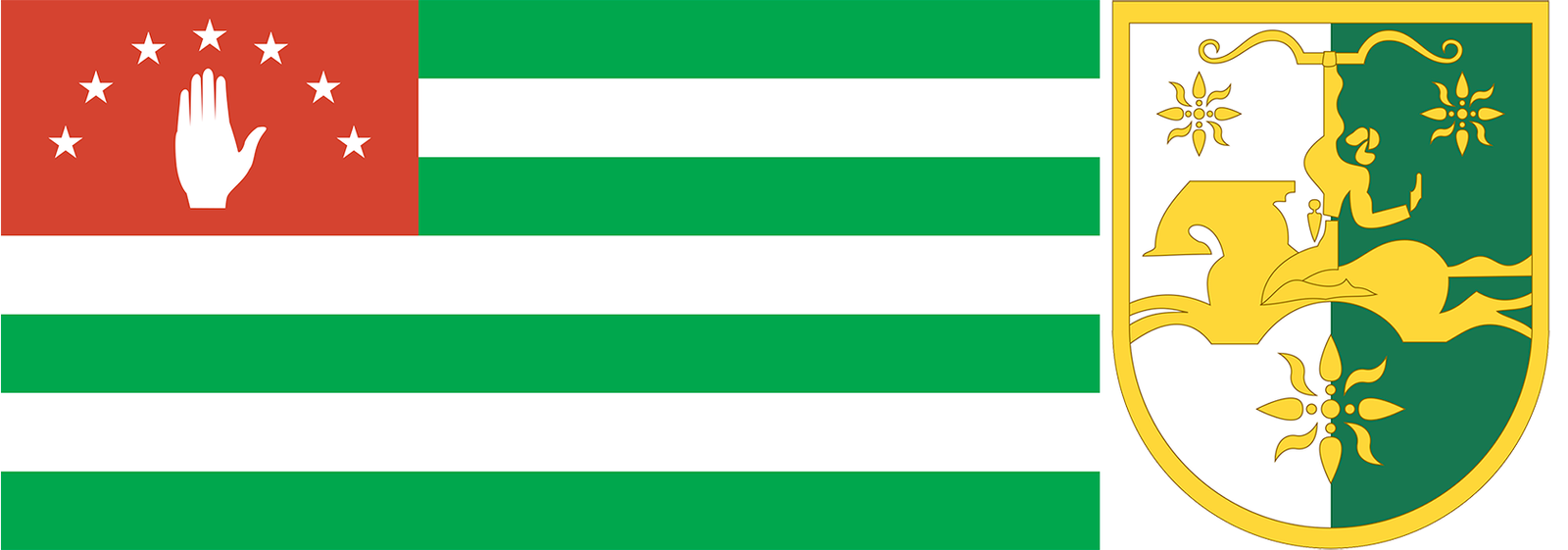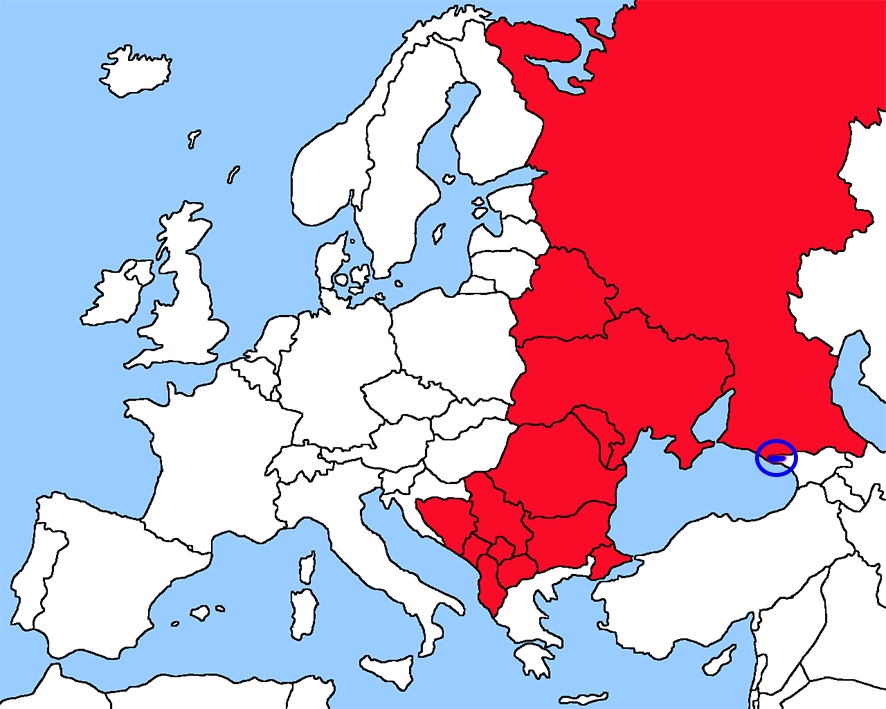FabulousFusionFood's Abkhazian Recipes Home Page
 The flag of Abkhazian (left) and the emblem of Abkhazian (right).
The flag of Abkhazian (left) and the emblem of Abkhazian (right).
Welcome to the summary page for FabulousFusionFood's Abkhazian recipes, part of Europe. This page provides links to all the Abkhazian recipes presented on this site, with 7 recipes in total.
This is a continuation of an entire series of pages that will, I hope, allow my visitors to better navigate this site. As well as displaying recipes by name, country and region of origin I am now planning a whole series of pages where recipes can be located by meal type and main ingredient. This page gives a listing of all the Abkhazian recipes added to this site.
Throughout the centuries, Albanian cuisine has been widely influenced by Albanian culture, geography and history, and as such, different parts of the country enjoy specific regional cuisines. Cooking traditions especially vary between the north and the south, owing to differing topography and climate that essentially contribute to the excellent growth conditions for a wide array of herbs, fruits, and vegetables.
These recipes, for the major part, originate in Abkhazian. Otherwise they are fusion recipes with major Abkhazian influences.
Abkhazia, officially the officially the Republic of Abkhazia (Аԥсны Аҳәынҭқарра (Aṕsny Aħəynţķarra) in Abkhaz and Республика Абхазия (Respublika Abkhaziya) in Russian) is a partially recognised state in the South Caucasus, on the eastern coast of the Black Sea, at the intersection of Eastern Europe and West Asia. It covers 8,665 square kilometres (3,346 sq mi) and has a population of around 245,000. Its capital and largest city is Sukhumi.
 The image above shows Abkhazia (in blue and circled) in relation to Eastern Europe (in red).The political status of Abkhazia is a central issue of the Abkhazia conflict and Georgia–Russia relations. Abkhazia is recognised as an independent state only by five states: Russia, Venezuela, Nicaragua, Nauru, and Syria; Georgia and other countries consider Abkhazia as Georgia's sovereign territory. Lacking effective control over the Abkhazian territory, Georgia maintains an Abkhaz government-in-exile.
The image above shows Abkhazia (in blue and circled) in relation to Eastern Europe (in red).The political status of Abkhazia is a central issue of the Abkhazia conflict and Georgia–Russia relations. Abkhazia is recognised as an independent state only by five states: Russia, Venezuela, Nicaragua, Nauru, and Syria; Georgia and other countries consider Abkhazia as Georgia's sovereign territory. Lacking effective control over the Abkhazian territory, Georgia maintains an Abkhaz government-in-exile.
The region had autonomy within Soviet Georgia at the time when the Soviet Union began to disintegrate in the late 1980s. Simmering ethnic tensions between the Abkhaz—the region's titular ethnicity—and Georgians—the largest single ethnic group at that time—culminated in the 1992–1993 War in Abkhazia, which resulted in Georgia's loss of control over most of Abkhazia and the ethnic cleansing of Georgians from Abkhazia. Despite a 1994 ceasefire agreement and years of negotiations, the dispute remains unresolved. The long-term presence of a United Nations Observer Mission and a Russian-led Commonwealth of Independent States peacekeeping force failed to prevent the flare-up of violence on several occasions. In August 2008, Abkhaz and Russian forces fought a war against Georgian forces, which led to the formal recognition of Abkhazia by Russia, the annulment of the 1994 ceasefire agreement and the termination of the UN mission. On 23 October 2008, the Parliament of Georgia declared Abkhazia a Russian-occupied territory
Etymology: The Russian name Абхазия (Abkhaziya) is adapted from the Georgian აფხაზეთი (Apkhazeti). Abkhazia's name in English (/æbˈkɑːziə/; ab-KAH-zee-ə or /æbˈkeɪziə/ ab-KAY-zee-ə).
The Abkhaz name Apsny (Abkhaz: Аԥсны, IPA [apʰsˈnɨ]) is etymologised as 'a land of the soul'; however, the literal meaning is 'a country of mortals'. It possibly first appeared in the seventh century in an Armenian text, perhaps referring to the ancient Apsilians. The Constitution of Abkhazia says the names of the 'Republic of Abkhazia' and 'Apsny' are equivalent and interchangeable.
One Abkhazian staple dish is cornmeal porridge (abysta), or corn meal boiled in water with no salt added. The same dish, with the addition of cheese is mamalyga. Its high starch, vitamin B1, and fibre content makes it a very healthy food. There is a number of variations on mamalyga, such as mamalyga with soft fresh cheese (ayladzh), or mamalyga with milk and cheese (achamykva). Corn meal is also used to make amgyal flatbread and a type of sweet called atsvyrtsma. Freshly gathered corn on the cob is another staple, boiled, fried or roasted over an open fire. Wheat flour is less widely used, mainly for cheese pies (achash, or khachapur) and cheese dumplings.
This is a continuation of an entire series of pages that will, I hope, allow my visitors to better navigate this site. As well as displaying recipes by name, country and region of origin I am now planning a whole series of pages where recipes can be located by meal type and main ingredient. This page gives a listing of all the Abkhazian recipes added to this site.
Throughout the centuries, Albanian cuisine has been widely influenced by Albanian culture, geography and history, and as such, different parts of the country enjoy specific regional cuisines. Cooking traditions especially vary between the north and the south, owing to differing topography and climate that essentially contribute to the excellent growth conditions for a wide array of herbs, fruits, and vegetables.
These recipes, for the major part, originate in Abkhazian. Otherwise they are fusion recipes with major Abkhazian influences.
Abkhazia, officially the officially the Republic of Abkhazia (Аԥсны Аҳәынҭқарра (Aṕsny Aħəynţķarra) in Abkhaz and Республика Абхазия (Respublika Abkhaziya) in Russian) is a partially recognised state in the South Caucasus, on the eastern coast of the Black Sea, at the intersection of Eastern Europe and West Asia. It covers 8,665 square kilometres (3,346 sq mi) and has a population of around 245,000. Its capital and largest city is Sukhumi.
 The image above shows Abkhazia (in blue and circled) in relation to Eastern Europe (in red).
The image above shows Abkhazia (in blue and circled) in relation to Eastern Europe (in red).The region had autonomy within Soviet Georgia at the time when the Soviet Union began to disintegrate in the late 1980s. Simmering ethnic tensions between the Abkhaz—the region's titular ethnicity—and Georgians—the largest single ethnic group at that time—culminated in the 1992–1993 War in Abkhazia, which resulted in Georgia's loss of control over most of Abkhazia and the ethnic cleansing of Georgians from Abkhazia. Despite a 1994 ceasefire agreement and years of negotiations, the dispute remains unresolved. The long-term presence of a United Nations Observer Mission and a Russian-led Commonwealth of Independent States peacekeeping force failed to prevent the flare-up of violence on several occasions. In August 2008, Abkhaz and Russian forces fought a war against Georgian forces, which led to the formal recognition of Abkhazia by Russia, the annulment of the 1994 ceasefire agreement and the termination of the UN mission. On 23 October 2008, the Parliament of Georgia declared Abkhazia a Russian-occupied territory
Etymology: The Russian name Абхазия (Abkhaziya) is adapted from the Georgian აფხაზეთი (Apkhazeti). Abkhazia's name in English (/æbˈkɑːziə/; ab-KAH-zee-ə or /æbˈkeɪziə/ ab-KAY-zee-ə).
The Abkhaz name Apsny (Abkhaz: Аԥсны, IPA [apʰsˈnɨ]) is etymologised as 'a land of the soul'; however, the literal meaning is 'a country of mortals'. It possibly first appeared in the seventh century in an Armenian text, perhaps referring to the ancient Apsilians. The Constitution of Abkhazia says the names of the 'Republic of Abkhazia' and 'Apsny' are equivalent and interchangeable.
Abkhazian Cuisine:
Abkhazian cuisine was shaped by the agricultural, climatic and economical factors of the area. Because the Abkhaz were mainly farmers and cattle-breeders, their basic dietary staples were corn, millet, and dairy products, particularly cheese. In the past, wild game and edible plants growing in the wild were a significant part of the diet, but today they are rarely on the table; but it explains why nuts remain a staple, particularly in the preparation of sauces.One Abkhazian staple dish is cornmeal porridge (abysta), or corn meal boiled in water with no salt added. The same dish, with the addition of cheese is mamalyga. Its high starch, vitamin B1, and fibre content makes it a very healthy food. There is a number of variations on mamalyga, such as mamalyga with soft fresh cheese (ayladzh), or mamalyga with milk and cheese (achamykva). Corn meal is also used to make amgyal flatbread and a type of sweet called atsvyrtsma. Freshly gathered corn on the cob is another staple, boiled, fried or roasted over an open fire. Wheat flour is less widely used, mainly for cheese pies (achash, or khachapur) and cheese dumplings.
The alphabetical list of all the Abkhazian recipes on this site follows, (limited to 100 recipes per page). There are 7 recipes in total:
Page 1 of 1
| Abkhazia Achamykva Origin: Abkhazia | Abysta (Cornmeal Polemnta) Origin: Abkhazia | Akutekarsh (Chicken with Nut Sauce) Origin: Abkhazia |
| Abkhazia Ayladzh Origin: Abkhazia | Achapa (Walnut Lobio) Origin: Abkhazia | |
| Abkhazia Mamalyga Origin: Abkhazia | Adjika (Paprika Sauce) Origin: Abkhazia |
Page 1 of 1